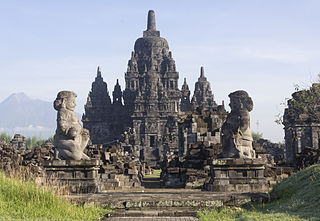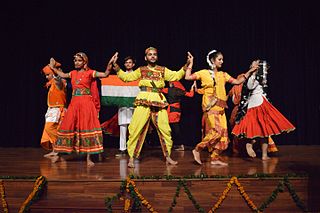
Majapahit, also known as Wilwatikta, was a Javanese Hindu-Buddhist thalassocratic empire in Southeast Asia that was based on the island of Java. It existed from 1293 to circa 1527 and reached its peak during the era of Hayam Wuruk, whose reign from 1350 to 1389 was marked by conquests that extended throughout Southeast Asia. His achievement is also credited to his prime minister, Gajah Mada. According to the Nagarakretagama written in 1365, Majapahit was an empire of 98 tributaries, stretching from Sumatra to New Guinea; consisting of present-day Indonesia, Singapore, Malaysia, Brunei, southern Thailand, Timor Leste, southwestern Philippines although the scope of Majapahit sphere of influence is still the subject of debate among historians. The nature of Majapahit's relations and influence upon its overseas vassals and also its status as an empire still provokes discussion.
Old Javanese or Kawi is the oldest attested phase of the Javanese language. It was spoken in the eastern part of what is now Central Java and the whole of East Java, Indonesia. As a literary language, Kawi was used across Java and on the islands of Madura, Bali, and Lombok. It had a sizable vocabulary of Sanskrit loanwords but had not yet developed the formal krama language register, to be used with one's social superiors that is characteristic of modern Javanese.
Gajah Mada, also known as Jirnnodhara, was a powerful military leader and mahapatih of the Javanese empire of Majapahit during the 14th century. He is credited in Old Javanese manuscripts, poems, and inscriptions with bringing the empire to its peak of glory.

Hayam Vuruk (1334–1389), also called Rajasanagara, Pa-ta-na-pa-na-wu, or Bhatara Prabhu after 1350, was a Javanese Hindu emperor from the Rajasa dynasty and the 4th emperor of the Majapahit Empire. Together with his prime minister Gajah Mada, he reigned the empire at the time of its greatest power. During his reign, the Hindu epics, the Ramayana and the Mahabharata, became ingrained in the culture and worldview of the Javanese through the wayang kulit. He was preceded by Tribhuwana Wijayatunggadewi, and succeeded by his son-in-law Wikramawardhana.

A Buddhist temple or Buddhist monastery is the place of worship for Buddhists, the followers of Buddhism. They include the structures called vihara, chaitya, stupa, wat and pagoda in different regions and languages. Temples in Buddhism represent the pure land or pure environment of a Buddha. Traditional Buddhist temples are designed to inspire inner and outer peace.

Unity in diversity is used as an expression of harmony and unity between dissimilar individuals or groups. It is a concept of "unity without uniformity and diversity without fragmentation" that shifts focus from unity based on a mere tolerance of physical, cultural, linguistic, social, religious, political, ideological and/or psychological differences towards a more complex unity based on an understanding that difference enriches human interactions. The idea and related phrase is very old and dates back to ancient times in both Western and Eastern Old World cultures. It has applications in many fields, including ecology, cosmology, philosophy, religion and politics.

The national emblem of Indonesia is called Garuda Pancasila. The main part is the Garuda with a heraldic shield on its chest and a scroll gripped by its legs. The shield's five emblems represent Pancasila, the five principles of Indonesia's national ideology. The Garuda claws gripping a white ribbon scroll inscribed with the national motto Bhinneka Tunggal Ika written in black text, which can be loosely translated as "Unity in Diversity". Garuda Pancasila was designed by Sultan Hamid II from Pontianak, supervised by Sukarno, and was adopted as the national emblem on 11 February 1950.

Buddhism has a long history in Indonesia, and is one of the six recognized religions in Indonesia, along with Islam, Christianity, Hinduism and Confucianism. According to 2022 estimates roughly 0.7% of the total citizens of Indonesia were Buddhists, and numbered around 2 million. Most Buddhists are concentrated in Jakarta, Riau, Riau Islands, Bangka Belitung, North Sumatra, and West Kalimantan. These totals, however, are probably inflated, as practitioners of Taoism and Chinese folk religion, which are not considered official religions of Indonesia, likely declared themselves as Buddhists on the most recent census. Today, the majority of Buddhists in Indonesia are Chinese, however small communities of native Buddhists also exist.

The Nagarakretagama or Nagarakṛtāgama, also known as Desawarnana or Deśavarṇana, is an Old Javanese eulogy to Hayam Wuruk, a Javanese king of the Majapahit Empire. It was written on lontar as a kakawin by Mpu Prapanca in 1365. The Nagarakretagama contains detailed descriptions of the Majapahit Empire during its greatest extent. The poem affirms the importance of Hindu–Buddhism in the Majapahit empire by describing temples and palaces and several ceremonial observances.
Kakawin are long narrative poems composed in Old Javanese, also called "Kawi", written in verse form with rhythms and meters derived from Sanskrit literature. Poets used a formalized literary language, rather than the vernacular. Poets composed and performed the poems at the courts of central and east Java kings between the 9th and 16th centuries, and in Bali.
Kakawin Sutasoma is an Old Javanese poem in poetic meters. It is the source of the motto of Indonesia, Bhinneka Tunggal Ika, which is usually translated as Unity in Diversity, although it means '(Although) in pieces, yet One'. It is not without reason that the motto was taken from this kakawin as the kakawin teaches religious tolerance, specifically between the Hindu and Buddhist religions.

The following is an alphabetical list of topics related to the Republic of Indonesia.

National symbols of Indonesia are symbols that represent Republic of Indonesia. It can represent Indonesia as a nation, Indonesian people, culture, arts, and its biodiversity. The official symbols of Indonesia are officially recognise symbols that represent Indonesia and enforced through Indonesian laws. These symbols of the state that represent Indonesian nationhood are Garuda Pancasila, Merah-Putih flag, Indonesia Raya national anthem, and Indonesian language.

Jawi temple is a syncretic Hindu-Buddhist candi (temple) dated from the late 13th century Singhasari kingdom. The temple is located on the eastern slope of Mount Welirang, Candi Wates village, Kecamatan Prigen, Pasuruan, East Java, Indonesia, approximately 31 kilometers west of Pasuruan city or 41 kilometers south of Surabaya. The temple is located on the main road between Kecamatan Pandaan – Kecamatan Prigen and Pringebukan. The temple was thought to be a Hindu-Buddhist place of worship, however, the temple was dedicated as a mortuary temple to honor King Kertanegara, the last king of Singhasari. It is believed that the ashes of the late king were also placed in two more temples, the Singhasari temple and the Jago temple.

Indonesian nationalism is an ideology that arose during the Dutch colonial era in the Dutch East Indies which called for the colony's independence and unification as an independent and sovereign nation. This period of nationalist development under colonial rule is often called the Indonesian National Awakening. After Indonesia declared independence in 1945 and was recognized as independent of the Netherlands following the 1949 Indonesian National Revolution, Indonesian nationalism persisted as a set of ideologies supporting the continued independence and development of the newly formed country. Because of the multiethnic nature of Indonesia, Indonesian nationalism does not consist of advocacy for a single ethnic group, and at times has manifested as civic nationalism, religious nationalism, and left-wing nationalism. Some of those forms are exemplified in Indonesia's national motto Bhinneka Tunggal Ika which means "Unity in Diversity" in Old Javanese, in the country's foundational ideology of Pancasila, or in contemporary laws which guarantee ethnic and religious diversity.
Mpu Tantular was a famous Javanese poet of Javanese literature who lived in the 14th century, during the reign of king Hayam Wuruk. Tantular was a Buddhist, and was respectful to other religions. This can be seen in two items of kakawin or poetry, the Kakawin Arjunawijaya and Kakawin Sutasoma. One of the verses from the Kakawin Sutasoma was later taken as the motto or motto of the Republic of Indonesia: "Bhinneka Tunggal Ika" or different but one.

The Majapahit flagand emblem refers to the royal colors and symbols used to represent the Majapahit empire. However, the nature of how the colors and the symbols were used and represented is still a subject of study and disagreement among historians.

Pancasila is the official, foundational philosophical theory of Indonesia. The name is made from two words originally derived from Sanskrit: "pañca" ("five") and "śīla".
Kakawin Arjunawijaya is an Old Javanese poem in poetic meters, written by Mpu Tantular between 1374 and 1379 CE.












